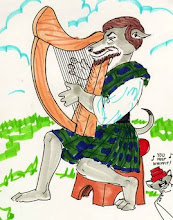THE WHIPPET
This graceful breed is nothing more or less than a miniature Greyhound, and was originally known as a snap dog by the colliers and working men in the north of England, who originated the breed, and used them for rabbit coursing. In later years these dogs have been taught straight running. That is, they are held in leash at a given mark by an attendant while the owner or some other person standing at the other end of the track shakes a handkerchief at the dogs and encourages them to race for it. There is an official starter, and the dogs are liberated at the shot of a pistol and immediately make a dash, straining every nerve to get at the handkerchief. The usual course is two hundred yards, and the dogs are handicapped according to weight or previous performances.
The origin of the Whippet was probably obtained by a cross between the small Greyhound and the white English Terrier. They are keen little sportsmen, easily kept in condition, and of a most companionable disposition.
In selecting a Whippet puppy at from two to four months old, the points to look for are almost identical with those of the Greyhound, of which it is a miniature, except that less bone is required and probably a little more arch of loin, both of which
49
variations are calculated to give the Whippet a little more speed, if less "staying" power, speed only being the great desideratum in the Whippet.
The points of the Whippet may be briefly summed up by saying he should be an exact duplicate in miniature of the Greyhound.
The following is the description of the Whippet, as formulated by the Whippet Club:
Head.—Long and lean, rather wide between the eyes, and flat at the top; the jaw powerful, yet clearly cut; teeth level and white.
Eyes.—Bright and fiery.
Ears.—Small, fine in texture, and rose shape.
Neck.—Long and muscular, elegantly arched, and free from throatiness.
Shoulders.—Oblique and muscular.
Chest.—Deep and capacious.
Back.—Broad and square, rather long, and slightly arched over loin, which should be strong and powerful.
Forelegs.—Rather long, well set under dog, possessing fair amount of bone.
Hindquarters.—Strong and broad across, stifles well bent, thighs broad and muscular, hocks well let down.
Feet.—Round, well split up, with strong soles.
Tail.—Long, tapering, and nicely carried.
Coat.—Fine and close.
Color.—Black, red, white, brindle, fawn, blue, and the various mixtures of each.
Weight.—20 pounds.
50




No comments:
Post a Comment